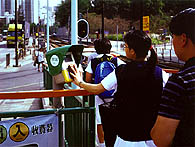
Smart card transit systems
1997
electronic ticket systems for public transport
This is a story of the transformation of a small Perth-based technology company into a global business researching, developing and implementing smart card transport systems around the world.
Energy Resources Group (ERG) began as a technology company in 1984 and had little success. In 1986 it recruited a new CEO and by 1987 had about ten employees but was making very little money. In the same year the company acquired a small Perth-based business that manufactured fare collection products and was interested in smart card technology. ERG became a fare collection and telecommunications business and formed an alliance with the Finnish company Nokia. Together they worked on projects for Optus Communications, Bell South NZ and Telstra. ERG also developed and operated the ?Met? ticketing system used on Melbourne buses, trams and trains.
ERG group established an international reputation in smart card technology when it designed and implemented the ?Octopus? system in Hong Kong. Launched in 1997, it processed over 6 million transactions per day. Using a single card, passengers could travel by bus, ferry, light rail, heavy rail and underground services provided by 30 operators. The ?Octopus? card could also be used to make purchases at food and leisure facilities, vending machines and telephones. To use a card a customer just wiped it, or their wallet, past the reader and the fare was deducted from the value on the card. The system was faster than inserting a ticket into a reader and eliminated the need for cash. Hong Kong was the first place to adopt widespread use of smart cards, and the system became a model for other cities around the world. At the end of the century this was the largest fully integrated smart card ticketing system operating in the world.
ERG won many awards for its work including the 1998 Sesames Award for the Best Smart Card Application, and the Business Asia 2000 Award for Best Use of Australian Technology in Asia. In 2000 ERG won an Australian Technology Award for Excellence in the Commercialisation of Technology.
ERG continued to design and implement similar smart card transit systems in Berlin, Rome, San Francisco, Manchester, Singapore and Toronto in partnership with other companies such as Motorola. By June 2000, ERG had become a global business with over 1000 employees and 18 offices in 12 countries across 4 continents. In 2001 it was part of a joint venture awarded the contract to convert Sydney?s public transport system to smart card use.
One important ingredient in ERG?s success in Australia and internationally has been partnership with other companies. These partners were able to provide skills, knowledge and resources to complement those of ERG. At the end of the century the company was spending 8-15% of revenue on R&D, and its main offices and R&D were based in Perth, Western Australia. The company had successfully adapted to market needs by focussing on its expertise in smart card applications.
Who Did It?
Key Organisations
ERG group
Key People
Peter Fogarty CEO
Further Reading
Carol H Fancher, 'Smart Cards', Scientific American, August 1996.
http://www.sciam.com/0896issue/0896fancher.html
Links
ERG group
Asia Pacific
Smart Card Forum
Smart Cards:
Big Brother's little helper. Privacy committee of NSW, 1995
Privacy
NSW
Card Technology
Smart Card News (UK)
Smart Card
Alliance
Smart Card Industry Association
|










